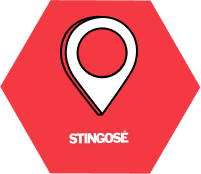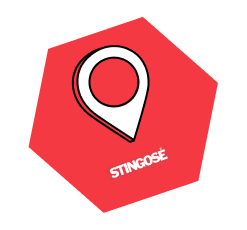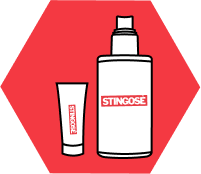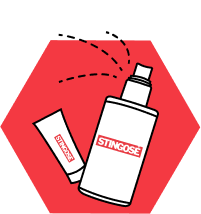Whether you’re dealing with mosquito bites, a wasp sting or a bee sting, there is no shortage of insects that can leave you itchy and sore. When it comes to bites and stings, it’s important to know ‘what’ you are dealing with so you can provide effective insect bites treatment and relief.
In this article, Stingose explains the most common types of insect stings and bites: as well as treatment options, and when to seek medical help for a severe allergic reaction.
Insect Bites Symptoms and First Aid
Most bites and stings may cause minor symptoms such as mild itching, pain or swelling and will typically clear up over a couple of days. First wash the area with soap and water and then keep it clean and dry. You can use ice and cool running water to help reduce any swelling and help relieve any pain. Using products such as Stingose Gel or Spray are also ideal at this point to help relieve the pain, itching and inflammation that follows most bites and stings.
Don’t use tourniquets, or cut the bite or sting site or try to suck out the ‘venom’!
Not everyone reacts to bites and stings the same way— sometimes reactions can be serious and life threatening. If you are experiencing a severe reaction, seek medical attention immediately — insect bite symptoms of a severe allergic reaction to watch-out for include:
Symptoms of Allergic Reactions Include:
- Swelling of the tongue or throat
- Difficulty breathing or talking
- Coughing or wheezing
- Dizziness
Common Bites and Stings
Here’s how to recognise and treat some common insect bites and stings we may encounter when out and about:
Mosquito bites are typically small, round, puffy bumps which appear almost immediately after being bitten. They quickly become hard, red and itchy, and usually last a couple of days. You may find that you get multiple mosquito bites at the same time, around the same area.
Once bitten, wash and clean the area. Most mosquito bites are mild, however, the pain and itchiness can be treated with icepacks, antihistamines, and insect bite relief products such as Stingose.
Bites from sandflies (also known as biting midges) are typically painful and itchy, though the severity of the reaction varies from person to person. The bites may form blisters or red bumps which can last for days or weeks. Unlike mosquito bites, the itching may not start until several hours after the bite.
Sandfly bites typically resolve themselves without treatment, however, icepacks, antihistamines and topical anti-itch products can help alleviate the painful and itchy symptoms.
Ants can bite and sting! Ants sting using the stinger located near their tail and bite using their mandibles and mouth parts. Some species of ant can bite and sting whereas others can do neither – but spray formic acid at you!
Generally, ant bites/stings result in a localised raised, bumpy rash (hives). More serious bites/stings such as fire ant bites can cause an itchy pustule lasting a few days to weeks.
Ant bites/stings can be very painful (particularly from fire ants) and the immediate treatment involves washing the area and applying a cool compress to minimise swelling. Following that, antihistamines, topical insect bite relief products and over-the-counter pain medication can be used to alleviate the pain and itching.
Bee stings are usually painful, red, swollen and itchy. The site of the stings will typically swell and turn red, with a white spot where the skin was punctured. Some bees can only sting once as they leave their stinger in the skin.
Bee sting first aid: Remove the stinger as soon as possible to minimise the amount of venom injected in the skin. Don’t use tweezers to pull it out as it may cause more venom to be released – instead, try removing the sting by gently scraping or sliding a sharp object across it, such as a bank card or a fingernail. Following that, wash the area and apply ice or a cold pack and a soothing cream. Oral antihistamines can be taken to minimise the itching.
A raised, red welt will typically appear around the site of a wasp sting, accompanied by a sharp pain and an itching or burning sensation. Wasps are aggressive and, unlike bees, they don’t tend to leave their stinger behind, which means they are capable of stinging multiple times!
When you are stung, clean the affected area and use ice or a cold pack to reduce the swelling. Pain medication, antihistamines or a soothing gel/spray such as Stingose can be used to help relieve the pain and itching.
Typical symptoms of sea lice bites include an immediate prickling sensation followed by itchiness. Red bumps then form and can merge to form a large itchy rash which can lasts up to 2 weeks.
The irritation is generally mild to moderate, and can be treated with over-the-counter products to minimise itching.
Insect bites generally clear up over a couple of days. If the stings or bites appear to worsen, look infected or don’t heal after several weeks, contact your doctor or pharmacist.
When to get Medical Advice
Seek Medical Advice from a healthcare professional if:
- You’re worried about a bite or sting.
- Your symptoms don’t start to improve within a few days or are getting worse.
- You’ve been stung or bitten in your mouth or throat, or near your eyes.
- A large area (around 10cm or more patch of skin) around the bite becomes red and swollen
- Your GP may refer you to an allergy clinic for further tests or treatment.
- You have symptoms of a wound infection, such as pus or increasing pain, swelling or redness.
- You have symptoms such as a fever and/or swollen glands.
When to get emergency help:
You should call for an ambulance or go to the emergency room immediately if you or someone else has symptoms of a severe reaction, such as:
- Wheezing or difficulty breathing.
- A swollen face, mouth, or throat.
- Feeling sick or being sick.
- A fast heart rate.
- Dizziness or feeling faint.
- Difficulty swallowing.
- Loss of consciousness.
Emergency treatment in hospital is needed in these cases.
For Most Insect Bites and Stings, Try Stingose
Insect bites and stings can be itchy, painful, and downright frustrating. But armed with the knowledge of what symptoms to look for and how to treat them, you can get relief fast. If you’re experiencing itching, inflammation or pain from your insect bite or sting – try Stingose. It’s a topical Gel or Spray that provides fast itch relief from insect bites and stings. Apply it as soon as possible after being bitten or stung for best results.




